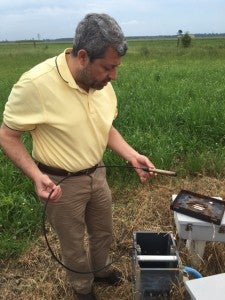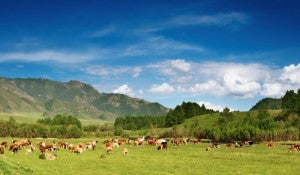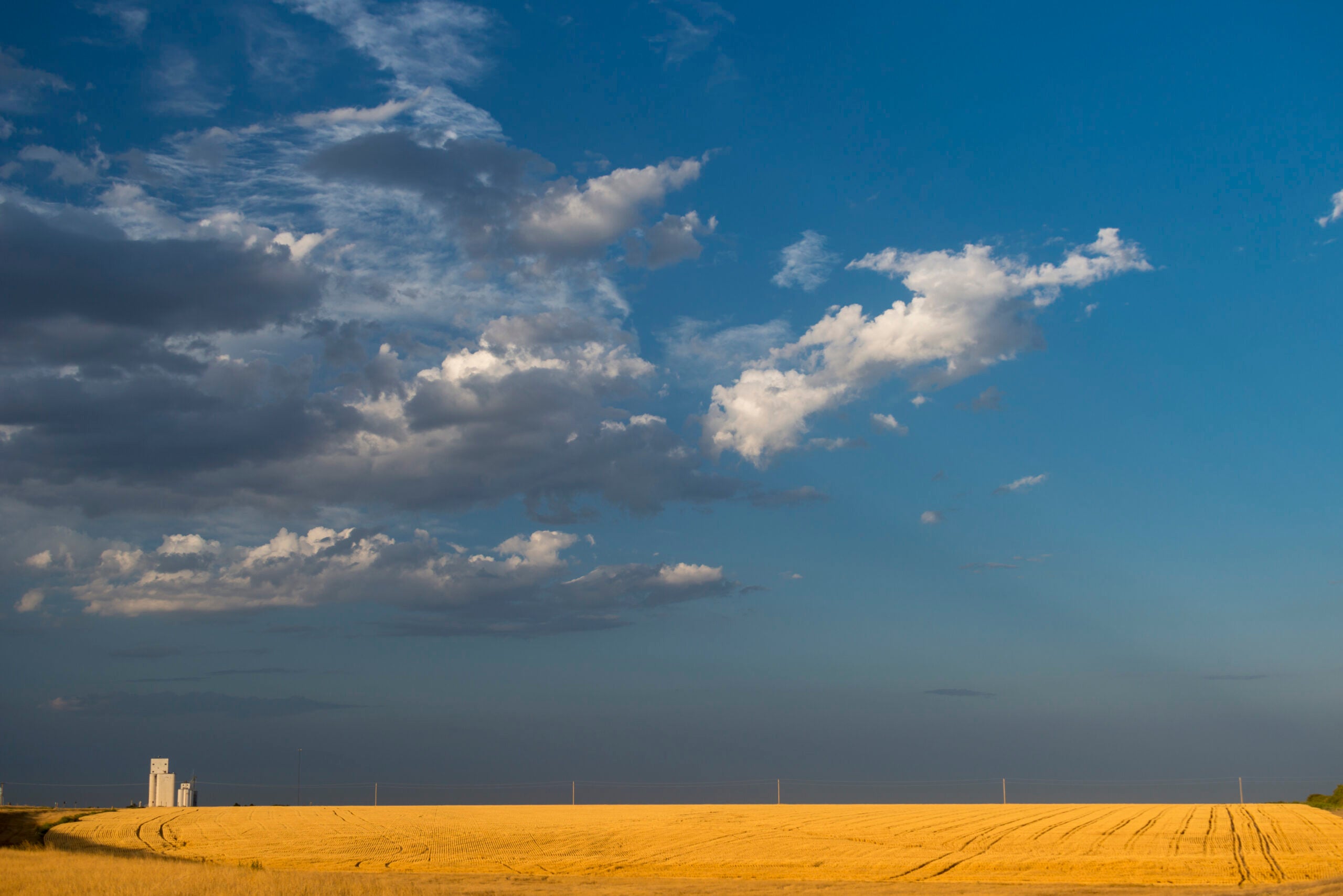During the summer of 2023, Kansas endured a historic heat wave with temperatures soaring above 110°F in some areas. As climate change continues to intensify, the frequency and severity of extreme heat are projected to increase. Are Kansas farmers at risk of losing money in the face of these extreme growing conditions? A new study by EDF, Kansas State University and Cornell University aimed to answer this question by examining the impacts of extreme heat over the last four decades.
Growing Returns
Selected tag(s): farm
Increasing extreme heat is hurting Kansas farmers’ bottom line
How companies can reduce nitrogen pollution and measure progress toward climate goals
Nitrogen is essential for life, but excess nitrogen can pollute the atmosphere and water. This has a huge impact on human and ecosystem health, as well as financial losses to farmers from fertilizer — which is at a record high price — that ultimately won’t be utilized by crops.
EDF’s new N Balance Implementation Guide provides a comprehensive and pragmatic road map for food and agriculture companies to help reduce nitrogen pollution from agricultural production and claim the environmental improvements associated with nitrogen management.
How farm transition plans can preserve conservation values and legacies
This blog is authored by Bethany Baratta, senior writer at Iowa Soybean Association.
A significant number of farmland acres in Iowa will be transferred to the next generation of farmers in the coming decade, providing a great opportunity for preserving and expanding conservation practices that have proven financial and resilience benefits.
According to Iowa State University, 60% of Iowa farmland is owned by people over the age of 65, and 35% of Iowa farmland is owned by those over 75. By 2024, landlords in the U.S. expect to transfer 91.5 million acres, or 10% of all U.S. farmland.
The way in which the land is transferred from one generation to the next could have a profound impact on the future of conservation efforts, and of the land itself. Read More
What Michael Pollan gets wrong about Big Ag
 Journalist Michael Pollan deserves credit for elevating the national conversation about food. Over the course of 25 years, his articles and books have thoughtfully contemplated the troubling side effects of the American diet and the way our food is produced.
Journalist Michael Pollan deserves credit for elevating the national conversation about food. Over the course of 25 years, his articles and books have thoughtfully contemplated the troubling side effects of the American diet and the way our food is produced.
But his latest piece in the New York Times Magazine reads like a script for a black and white Western, with food companies, agribusiness and commodity producers cast in the role of Bad Guy and local organic farmers and vegans cast as the Men in White Hats.
In Pollan’s script, the bad guys are responsible for everything from America’s weight problem and rising health care costs to widespread environmental degradation and monocultures that threaten national security. If only the law would get on the good guys’ side, he muses.
Food production is actually changing
All industries have issues that continually need to be addressed, and the food industry is no exception.
Agriculture consumes a lot of land and water and emits greenhouse gas emissions that must be curbed. And, yes, our diets have contributed to America’s obesity epidemic.
Except, our food system is changing, more than Pollan acknowledges.
The uptick in consumer demand for local, organic products is promising. So, too, are the contributions that Pollan’s so-called villains – the companies, agribusinesses and commodity farmers who produce what’s on our plate – are making to the environment. They deserve recognition. Read More
Why collaboration between ag equipment and tech companies is a good thing for the environment
 In order for the agriculture sector to deliver on the growing demand for sustainable grain and participate in emerging carbon markets, growers need a way to demonstrate that their management practices are benefiting the environment.
In order for the agriculture sector to deliver on the growing demand for sustainable grain and participate in emerging carbon markets, growers need a way to demonstrate that their management practices are benefiting the environment.
Scientists have identified multiple practices that farmers can implement to maximize yield while minimizing impacts to air and water. Meanwhile, companies such as Trimble Ag, John Deere, SST Software, and countless others have developed a wide array of sensing tools and data collection methodologies to calculate and monitor the environmental benefits of these practices.
Yet as one might expect in any emerging market, the tools aren’t fully communicating with each other, thereby limiting their true potential.
The good news is that the makers of these technologies have started collaborating with agricultural practitioners to make their systems more compatible. Even in this fragmented industry, companies are starting to work together to streamline data collection – and this has enormous implications for sustainability.
Here’s why. Read More
Controlled drainage is the new black

Dr. Mohamed Youssef demonstrates the benefits of controlled drainage.
NC State University’s agriculture water management expert Mohamed Youssef, Ph.D, believes the time is ripe for controlled drainage to make a comeback.
Controlled drainage is one of the most effective ways to minimize nitrogen loss from croplands. It’s a management practice involving the use of a control structure installed at the outlet of a drainage ditch or subsurface drain to regulate drainage water outflow according to plant needs and field operations.
“A controlled drainage system can remove between 40 and 60 percent of the nitrogen present in runoff, if used at a large scale. These systems hold huge potential to reduce pollution from very large flows of water runoff,” Youssef explained during my recent visit to NC State’s demonstration farms in eastern North Carolina.
Despite the promise, adoption rates for this practice remain very low, in part because of functionality problems with the first controlled drainage structures. But thanks to new advances in the technology that I recently viewed in the field, adoption rates are rising.
Like any filter practice, controlled drainage is just one tool that can help solve regional water quality problems. It’s not a silver bullet, especially with some geographic limitations since they can be used only on low-sloping fields. While there is no perfect solution to stop farm runoff, after seeing drainage systems first-hand, I too believe we’re nearing a tipping point for widespread adoption of controlled drainage in agriculture – and big environmental benefits. Here’s the story. Read More
Why grasslands can bring in the green for growers
 Rebecca Haynes is a High Meadows Fellow with EDF’s Agriculture Greenhouse Gas Markets program.
Rebecca Haynes is a High Meadows Fellow with EDF’s Agriculture Greenhouse Gas Markets program.
Next week, hundreds of ranchers, landowners, land trusts, and environmental groups will gather in Stockton, California, for the California Rangeland Conservation Coalition’s annual summit. The event isn’t new, but the enthusiasm from attendees is unprecedented and palpable.
Why such a bustle in the grasses? Because of two recent landmark developments that reward ranchers for avoiding the conversion of grasslands to croplands:
- In August, the Climate Action Reserve (one of the offset registries that oversees carbon credit development) approved a new voluntary grasslands protocol that offers payment for conservation activities.
- In September, the Climate Action Reserve received a Conservation Innovation Grant (CIG) from the USDA to create a pilot grasslands project in coordination with EDF. This project will assist participating landowners in generating carbon credits. If adopted by the California Air Resources Board in the future, these credits could be sold in the California cap-and-trade market.
These two developments are part of a rapidly growing trend that offers landowners payments for conservation measures. Protecting grasslands means big wins for the planet and for ranchers, who have been committed partners in conservation and now have the opportunity to receive additional incentives to protect their landscapes. Here’s how it all works. Read More
Cutting food waste to support farmers and the famished

Surplus food at the Food Donation Connection. Photo Credit: USDA.
Food waste affects more than just our wallets. Approximately one-third of all food produced in the world gets thrown away every year, leading to 3.3 billion tons of greenhouse gas emissions. At 2.6 trillion pounds, that’s enough sustenance to feed three billion people, or almost all people living in poverty worldwide today.
That’s why, last week, when I attended a Q&A session for ag interns at the U.S. Department of Agriculture with Secretary Tom Vilsack, I was intrigued when a fellow intern asked a question regarding food sustainability and what the U.S. can do to ensure that there will be enough food to feed the 9 billion people expected to populate the world by 2050.
The Secretary’s answer? Reduce food waste.
Sustainability and profitability go hand-in-hand, says Iowa corn farmer

Tim Richter, owner of Saratoga Partnership.
Farming is a tough business. With constantly changing crop prices, difficult to predict and increasingly extreme weather variations, and changing consumer demands, growers don’t have an easy time of it.
Like any business, profitability is the number one priority. And it should be – if you are not profitable, it’s very hard to stay in business.
All the growers I’ve worked with care deeply about their land. In a recent survey of a group of Midwestern farmers, “land stewardship” ranked as their top value. And sustainability is in a farmers’ best interest since healthy lands plays a huge role in whether farms will be around – and productive – for the next generation. But making agriculture truly sustainable will require investment from farmers.
Here’s the good news: sustainability and profitability can go hand-in-hand. Efficiencies like fertilizer optimization can result in cost savings. And with those savings, growers can invest in new technologies and cover crops, which can help make farms more resilient and increase yields, generating long term economic gain.
I asked Tim Richter, owner of a swine and corn farm operation spanning 9,000 acres in northern Iowa and Missouri, to tell me his profitability and sustainability story. Read More
How cover crops can help growers beat droughts and floods
Corn is trying to fight this summer’s extreme weather, and unfortunately, the weather is winning.
There are serious floods in the Midwest, devastating droughts in California, and brutal heat waves along the eastern seaboard. Ohio for example had a record June rainfall of 11 inches, which stunted corn roots and prevented many growers from planting any corn crops. In Northwest Ohio alone, 100,000 acres were left unplanted. At the same time, places in my home state of North Carolina experienced a June heat wave during the critical corn pollination period, significantly damaging corn yields.
These extreme weather events leave many farmers searching for ways to make the best of a challenging growing season. Although June’s weather was the opposite in Ohio and North Carolina, cover crops offer a proven solution to deal with both conditions. Read More












